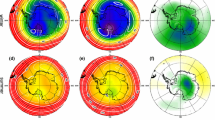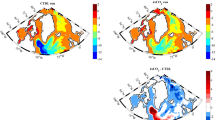Abstract
An atmospheric general circulation model, the NCAR CCM, has been used to investigate the possible effects of two specific tectonic mechanisms on Antarctic glaciation. These two mechanisms are: (1) closing the Drake Passage (connecting South America with Antarctica), which is assumed to effectively represent an increased meridional heat transport by the ocean; and (2) changing the elevation of Antarctica. Perpetual season (summer and winter) and seasonal cycle simulations with warmer sea-surface temperatures and no sea ice prescribed for mid- to high-latitude southern oceans have been made with both present-day (high) Antarctic elevations and with low Antarctic elevations (all points ≤200 m). The results suggest a relatively minor role for oceanic heat transport in the formation/elimination of Antarctic glaciation. That is, under the warmer conditions inferred to have prevailed prior to the opening of the Drake Passage, conditions would still have been favorable for the maintenance of an Antarctic ice-sheet. If anything, a moderate ocean warming would promote glaciation, by increasing snowfall. Lowering the elevation of Antarctica has a larger effect on the model simulations, reducing the likelihood of glacial conditions. In the absence of snowcover, summer temperatures over Antarctica can warm considerably, leading to a monsoon-like circulation. However, it may be difficult to achieve such snow-free conditions, even with greatly increased atmospheric carbon dioxide. A tundra-like climate is the closest the model has come to representing a non-glacial climate, even when both seasurface temperatures and elevations are maximally varied.
Similar content being viewed by others
References
Axelrod DI (1984) An interpretation of Cretaceous and Tertiary biota in polar regions. Paleogeogr Paleoclimatol Paleoecol 45:105–147
Barker PF, Burrell J (1977) The opening of Drake Passage. Marine Geol 25:15–34
Barker PF, Burrell J (1982) The influence upon southern ocean circulation, sedimentation, and climate of the opening of Drake Passage. In: Craddock C (ed) Antarctic geoscience. University of Wisconsin, Madison, pp 377–385
Barrett PJ, Elston DP, Harwood DM, McKelvey BC, Webb P-N (1987) Mid-Cenozoic record of glaciation and sealevel change on the margin of the Victoria Land basin, Antarctica. Geology 15:634–637
Barrett PJ, Hambrey MJ, Barrera E, Harwood DM, Webb P-N (1988) Middle Cenozoic glacial and sea level history from CIROS-1 drillhole, Victoria Land basin, Antarctica. EOS Am Geophys Union 69:383
Barron EJ (1983) A warm, equable Cretaceous: The nature of the problem. Earth Sci Rev 19:305–338
Barron EJ, Harrison CGA, Sloan JL, Hay WW (1981) Pateogeography 180 million years ago to the present. Eclogae Geol Helv 74:443–470
Barron EJ, Washington WM (1984) The role of geographic variables in explaining paleoclimates: results from Cretaceous climate model sensitivity studies. J Geophys Res 89:1267–1279
Barron EJ, Washington WM (1985) Warm Cretaceous climates: high atmospheric CO2 as a plausible mechanism. In: Sundquist ET, Broecker WS (eds) The carbon cycle and atmospheric CO2: natural variations Archean to present. Geophys Monogr Washington 32:546–553
Barry RG (1981) Mountain weather and climate. Methuen, London, pp 313
Berner RA, Barron EJ (1984) Comments on the BLAG model: factors affecting atmospheric CO2 and temperature over the past 100 million years. Am J Sci 284:1183–1192
Blackmon ML (1986) Building, testing, and using a general circulation model. In: Wilebrand J, Anderson DLT (eds) Large-scale transport processes in oceans and atmospheres. Reidel, Dordrecht, pp 1–70
Chervin RM (1980) On the simulation of climate and climate change with general circulation models. J Atmos Sci 37:1903–1913
Chervin RM, Schneider SH (1976) Statistical significance of climate experiments with general circulation models. J Atmos Sci 33:405–412
Creber GT, Chaloner WG (1985) Tree growth in the Mesozoic and early Tertiary and the reconstruction of paleoclimates. Paleogeogr Paleoclimatol Paleoecol 52:35–60
Crowell JC (1982) Continental glaciation through geologic time. In: NRC Geophysics Committee (ed) Climate in earth history (Studies in geophysics). National Academy Press, Washington, pp 77–82
Crowley TJ (1983) The geological record of climatic change. Rev Geophys Space Phys 21:828–877
Crowley TJ, Short DA, Mengel JG, North GR (1986) Role of seasonality in the evolution of climate during the last 100 million years. Science 231:579–584
Dalrymple PC (1966) A physical climatology of the Antarctic Plateau. In: Rubin MJ (ed) Studies in antarctic meteorology. Antarctic Res series. Am Geophys Un Washington 9:195–231
Foster RJ (1974) Eocene echinoids and the Drake Passage Nature 249:751
Frakes LA (1979) Climates throughout geologic time. Elsevier, Amsterdam, pp 310
Frakes LA (1986) Mesozoic-Cenozoic climatic history and causes of the glaciation. In: Hsü KJ (ed) Mesozoic and Cenozoic oceans. Geodynamics series. Am Geophys Un Washington 15:33–48
Frakes LA, Francis JE (1988) A guide to Phanerozoic cold polar climates from high-latitude ice-rafting in the Cretaceous. Nature 333:547–549
Hunt BG (1984) Polar glaciation and the genesis of ice ages. Nature 308:48–50
Kemp EM (1978) Tertiary climatic evolution and vegetation history in the southeast Indian Ocean region. Paleogeogr Paleoclimatol Paleoecol 24:169–208
Kemp EM, Barrett PJ (1975) Antarctic glaciation and early Tertiary vegetation. Nature 258:507–508
Kennett JP (1977) Cenozoic evolution of Antarctic glaciation, the circum-Antarctic ocean, and their impact on global paleoceanography. J Geophys Res 82:3843–3860
Kennett JP (1986) Miocene paleoceanography and plankton evolution. In: Hsü KJ (ed) Mesozoic and Cenozoic oceans. Geodynamics Series Am Geophys Un Washington 15:119–122
Kennett JP, Houtz RE, Andrews PB, Edwards AR, Gostin VA, Hajoś M, Hampton M, Jenkins DG, Margolis SV, Ovenshine AT, Perch-Nielsen K (1975) Cenozoic paleoceanography in the southwest Pacific Ocean, Antarctic glaciation, and the development of the circum-antarctic current. In: JP Kennett, RE Houtz (eds) Initial reports of the Deep Sea Drilling Project 29. US Government Printing Office, Washington, pp 1155–1169
Kennett JP, Shackleton NJ (1976) Oxygen isotopic evidence for the development of the psychrosphere 38 Myr ago. Nature 260:513–515
Kutzbach JE, Guetter PJ (1986) The influence of changing orbital parameters and surface boundary conditions on climate simulations for the past 18000 years. J Atmos Sci 33:1726–1759
Leg 113 Shipboard Scientific Party (1987) Glacial history of Antarctica. Nature 328:115–116
Leg 119 Shipboard Scientific Party (1988) Early glaciation of Antarctica. Nature 333:303–304
Levitus S (1982) Climatological Atlas of the World Ocean. NOAA Professional Paper 13, pp 173
Manabe S, Wetherald RT (1985) CO2 and hydrology. In: Manabe S (ed) Issues in atmospheric and ocean modeling Part A. Climate dynamics. Advances in geophysics 28. Academic Press, Orlando, pp 131–158
Matthews E (1983) Global vegetation and land use: New highresolution data bases for climate studies. J Climatol Appl Meteorol 22:474–487
Matthews RK, Poore RZ (1980) Tertiary δ18O record and glacio-eustatic sea-level fluctuations. Geology 8:501–504
Muza JP, Williams DF, Sherwood WW Jr (1983) Paleogene oxygen isotope record for deep-sea drilling sites 511 and 512, subantarctic south Atlantic ocean: paleotemperatures, paleocenographic changes, and the Eocene/Oligocene boundary event. In: JH Blakeslee, M Lee (eds) Initial reports of the Deep sea Drilling Project 71. US Government Printing Office, Washington, pp 409–422
North GR, Cahalan RF, Coakley JA (1981) Energy balance climate models. Rev Geophys Space Phys 19:91–121
Pitcher EJ, Malone RC, Ramanathan V, Blackmon ML, Puri K, Bourke W (1983) January and July simulations with a spectral general circulation model. J Atmos Sci 40:580–604
Ramanathan V, Lian MS, Cess RD (1979) Increased atmospheric CO2: zonal and seasonal estimates of the effects on the radiation energy balance and surface temperature. J Geophys Res 84:4949–4958
Ramanathan V, Pitcher EJ, Malone RC, Blackmon ML (1983) The response of a spectral general circulation model to refinements in radiative processes. J Atmos Sci 40:605–631
Reid JL, Nowlin WD Jr (1971) Transport of water through the Drake Passage. Deep-Sea Res 18:51–64
Rubin MJ (1964) Antarctic weather and climate. In: Odishaw H (ed) Research in geophysics 2: solid earth and interface phenomena. MIT Press, Cambridge, pp 461–478
Saltzman B, Vernekar AD (1971) An equilibrium solution for the axially symmetric component of the Earth's macroclimate. J Geophys Res 76:1498–1524
Savin SM (1977) The history of the Earth's surface temperature during the past 100 million years. Annu Rev Earth Planet Sci 5:319–355
Schlesinger ME (1986) Equilibrium and transient climatic warming induced by increased atmospheric CO2. Climate Dyn 1:35–51
Schneider SH, Thompson SL, Barron EJ (1985) Mid-Cretaceous continental surface temperatures: Are high CO2 concentrations needed to simulate above-freezing winter conditions? In: Sundquist ET, Broecker WS (eds) The carbon cycle and atmospheric CO2: natural variations Archean to present. Geophys Monogr Am Geophys Un Washington, 32:554–560
Schwerdtfeger W (1984) Weather and climate of the Antarctic. Elsevier, Amsterdam, 261 pp
Shackleton NJ (1986) Paleogene stable isotope events. Paleogeogr Paleoclimatol Paleoecol 57:91–102
Shackleton NJ, Kennett JP (1975) Pateotemperature history of the Cenozoic and the initiation of Antarctic glaciation: Oxygen and carbon isotope analysis in dsdp sites 277, 279, and 281. In: JP Kennett, RE Houtz (eds) Initial reports of the Deep Sea Drilling Project 29. US Government Printing Office, Washington, pp 743–755
Smith AG, Hurley AM, Briden JC (1981) Phanerozoic Paleocontinental World Maps. Cambridge University Press, Cambridge, pp 102
Washington WM, Meehl GA (1983) General circulation model experiments on the climatic effects due to a doubling and quadrupling of carbon dioxide concentration. J Geophys Res 88:6600–6610
Williamson DL, Kiehl JT, Ramanathan V, Dickinson RE, Hack JJ (1987) Description of NCAR community climate model (CCM1). NCAR technical note NCAR/TN-285+STR, Boulder, pp 112
Woodruff F, Savin SM, Douglas RG (1981) Miocene stable isotope record: A detailed deep Pacific Ocean study and its paleoclimatic implications. Science 212:665–668
Author information
Authors and Affiliations
Rights and permissions
About this article
Cite this article
Oglesby, R.J. A GCM study of Antarctic glaciation. Climate Dynamics 3, 135–156 (1989). https://doi.org/10.1007/BF01080365
Received:
Accepted:
Issue Date:
DOI: https://doi.org/10.1007/BF01080365




